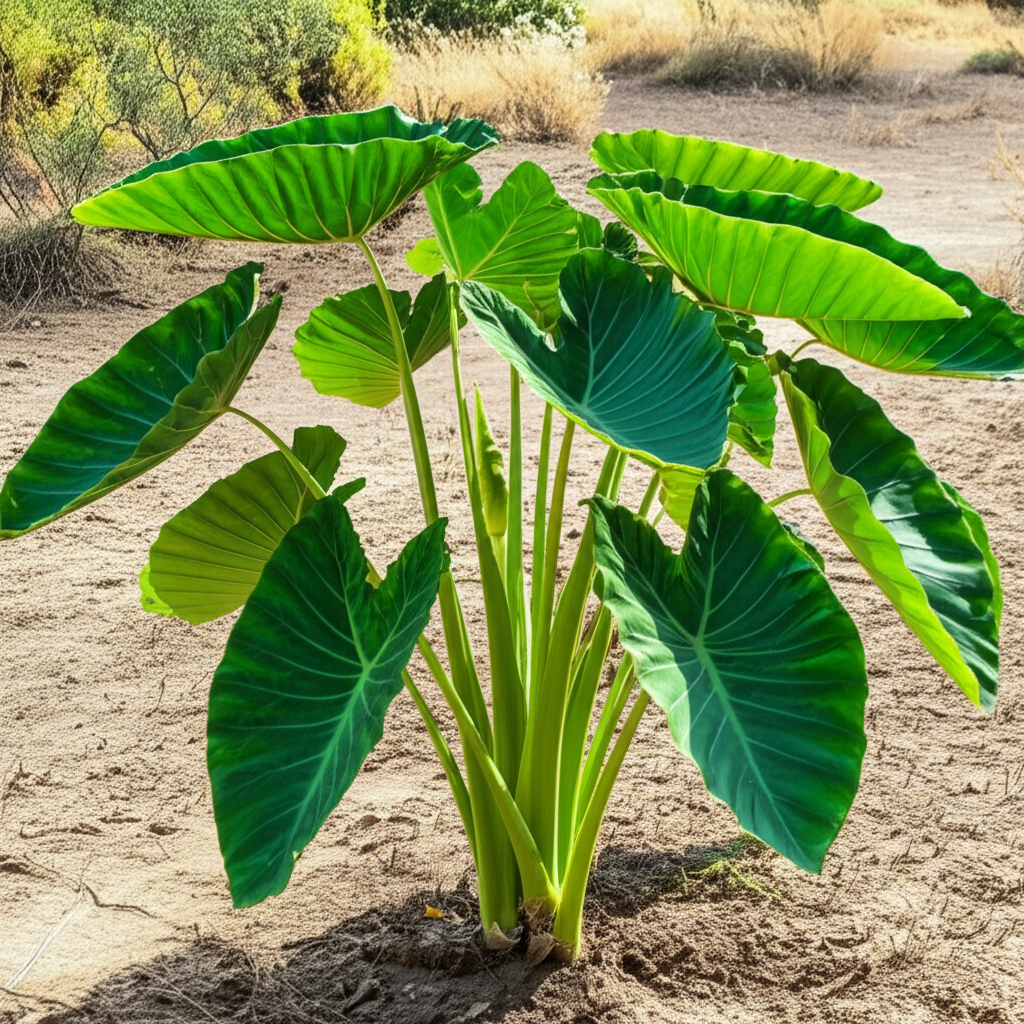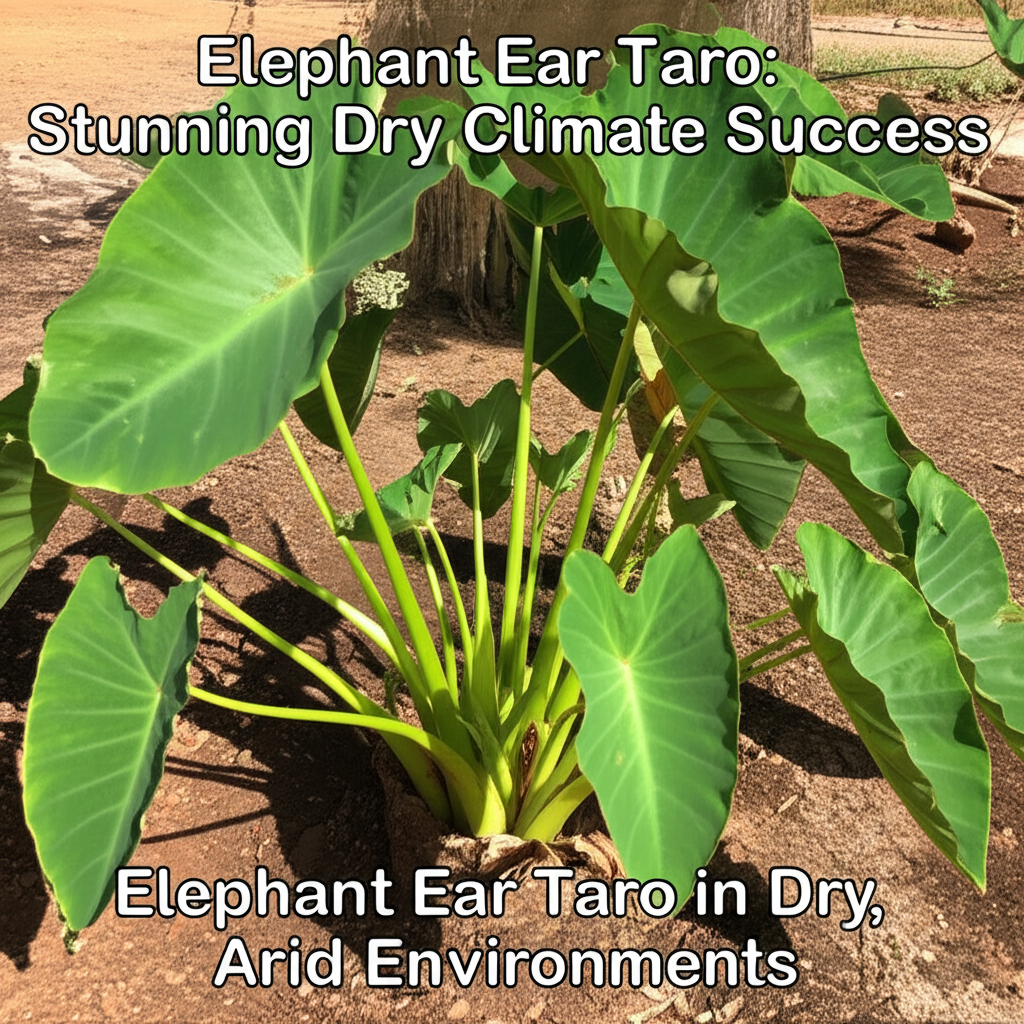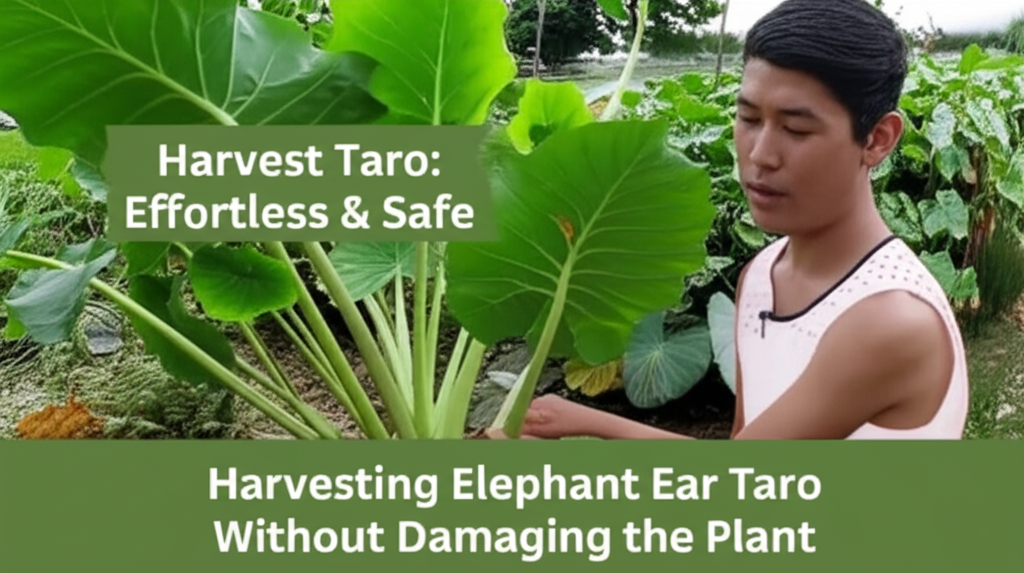Elephant Ear Taro: Stunning Dry Climate Success

Can you imagine a garden that bursts with lush, tropical-looking foliage, even in the most challenging dry and arid environments? If you’ve ever admired the dramatic, oversized leaves of Elephant Ear plants and thought they were strictly for humid, tropical locales, think again! The question many gardeners grapple with is: Can Elephant Ear Taro thrive in dry, arid environments? The answer might surprise you, and understanding how to achieve this horticultural feat can transform your landscape from parched to paradise, boosting your garden’s visual appeal and demonstrating a remarkable feat of plant adaptation.
Quick Answer Box
Yes, with the right care and variety selection, Elephant Ear Taro (Colocasia esculenta and its many cultivars) can indeed thrive in dry, arid environments. While they naturally prefer moist conditions, specific strategies focusing on soil moisture retention, strategic watering, and choosing drought-tolerant varieties can lead to stunning success.
What is Elephant Ear Taro and Why It’s Important in Gardening?
Elephant Ear Taro, scientifically known as Colocasia esculenta, is a tropical perennial plant renowned for its large, heart-shaped or arrow-shaped leaves that can grow to impressive sizes, often resembling the ears of an elephant. These plants are native to Southeast Asia and are cultivated not only for their ornamental value but also for their edible tubers, which are a staple food in many cultures. In gardening, Colocasia esculenta is prized for its ability to create a dramatic, lush, and exotic aesthetic, instantly adding a tropical flair to any garden bed, pond edge, or container planting.
The importance of understanding how to grow Elephant Ear Taro in drier climates lies in its potential to expand the horticultural palette available to gardeners in regions with limited water resources. It challenges the notion that only certain types of plants can survive and flourish in arid conditions, encouraging more diverse and visually striking landscapes. Successfully growing these plants in drier environments also highlights innovative water management techniques and a deeper appreciation for plant resilience, contributing to more sustainable gardening practices.
Quick Recommendations or Key Insights about Elephant Ear Taro in Dry, Arid Environments
Variety Selection is Key: Opt for cultivars known for greater drought tolerance.
Soil is Your Ally: Amend soil with plenty of organic matter to improve water retention.
Strategic Watering: Deep, infrequent watering is generally better than shallow, frequent watering.
Mulch Generously: A thick layer of mulch conserves soil moisture and regulates temperature.
Morning Sun, Afternoon Shade: Protect plants from intense afternoon sun, especially in hot climates.
Container Gardening: Pots offer more control over soil moisture and temperature.
Dormancy is Natural: Expect reduced growth or dormancy during extreme dry periods.
Detailed Breakdown of Elephant Ear Taro in Dry, Arid Environments
Can Elephant Ear Taro Survive and Flourish in Dry, Arid Environments?
The short answer is a resounding yes, but it requires a nuanced approach. Colocasia esculenta is a geophyte, meaning it grows from a corm (a swollen underground stem) and has a natural preference for moist, boggy soils, often found near water bodies in its native habitat. This evolutionary predisposition makes it seem counterintuitive to suggest it can thrive in arid conditions.
The Scientific Perspective: Colocasia esculenta is a relatively adaptable plant. Its large leaves, while beautiful, can also lead to significant water loss through transpiration, especially in hot, dry, and windy conditions. In its natural environment, the constant moisture available in the soil, coupled with high humidity, mitigates this. However, the plant’s corm serves as a crucial storage organ for water and nutrients, allowing it to endure periods of less favorable conditions. When grown in drier climates, the success hinges on mimicking its preferred conditions as much as possible within the limitations of the environment, primarily by ensuring consistent, albeit controlled, moisture and protecting the plant from extreme heat stress.
Practical Applications: Gardeners in arid regions can leverage this by understanding the plant’s needs and providing them. This involves selecting the right location, amending the soil to hold moisture, and implementing a smart watering schedule. It’s not about replicating a swamp, but about creating a microclimate that supports the plant’s life cycle.
Common Myths: A prevalent myth is that Elephant Ear Taro is an exclusively water-loving plant that simply cannot survive without constantly wet feet. While it prefers moisture, this doesn’t mean it will instantly perish if the soil dries out slightly between waterings, especially if it has a healthy corm and is protected from the harshest elements. Another myth is that all Elephant Ear varieties are equally drought-tolerant, which is not true; some cultivars are significantly more resilient than others.
How to Grow Elephant Ear Taro Successfully in Dry Climates: A Step-by-Step Guide
Successfully cultivating Elephant Ear Taro in arid environments is an art that combines careful planning, soil preparation, and vigilant watering. Here’s a comprehensive guide to help you achieve that lush, tropical look:
Step 1: Choose the Right Variety
Not all
‘Black Magic’ (Colocasia esculenta ‘Black Magic’): While it loves moisture, its dark foliage can tolerate some dryness better than lighter-leaved varieties.
‘Maui Gold’ (Colocasia esculenta ‘Maui Gold’): Known for its vibrant yellow leaves, this variety can also adapt.
Native or Adapted Varieties: Research local nurseries or botanical gardens for Colocasia or related species that have been successfully grown in your specific climate. Sometimes, specific cultivars are bred for or have naturally adapted to drier conditions.
Step 2: Site Selection – Location, Location, Location!
The spot you choose is critical for mitigating the effects of a dry climate.
Morning Sun, Afternoon Shade: This is paramount. The intense midday and afternoon sun of arid regions can scorch the leaves and dry out the soil rapidly. A location that receives gentle morning sun and dappled or shaded afternoon sun is ideal.
Protection from Wind: Arid environments often experience strong winds, which accelerate transpiration and can physically damage the large leaves. Planting near a wall, fence, or other larger, drought-tolerant plants can provide a windbreak.
Proximity to Water Source: While not essential for it to be in water, being closer to a water source can make watering more convenient and ensure you can provide adequate moisture when needed.
Step 3: Soil Preparation – The Foundation for Success
The soil in arid regions is often sandy and drains too quickly, which is the antithesis of what Elephant Ear Taro prefers.
Amend Heavily with Organic Matter: This is the most crucial step. Incorporate generous amounts of compost, well-rotted manure, or peat moss into the planting hole and surrounding soil. Organic matter acts like a sponge, retaining moisture and nutrients. Aim for a mix where organic matter comprises at least 30-50% of the soil.
Improve Drainage (but not too much): While good drainage is important to prevent corm rot, in arid climates, you want the soil to hold moisture. Avoid overly sandy soils without amendment. If your soil is heavy clay, amend it with compost to improve aeration and moisture retention.
Planting Depth: Plant the corms about 4-6 inches deep. A deeper planting can help protect the corm from temperature fluctuations and surface drying.
Step 4: Watering – The Balancing Act
This is where the “dry climate” aspect requires careful management.
Water Deeply and Infrequently: When you water, water thoroughly so that moisture penetrates deep into the root zone. Allow the top inch or two of soil to dry out slightly between waterings. This encourages deeper root growth and makes the plant more resilient.
Monitor Soil Moisture: Use your finger to check the soil moisture. If it feels dry an inch or two down, it’s time to water. For container plants, this is even more critical.
Watering Schedule: In the peak of summer heat, you might need to water every 3-7 days, depending on the temperature, humidity, and your soil’s water-holding capacity. In cooler months or during periods of rain, reduce watering frequency.
Watering Method: Water at the base of the plant to avoid wetting the foliage, which can encourage fungal diseases, especially in humid conditions that might occur even in arid regions.
Step 5: Mulching – Your Moisture Guardian
Mulch is an indispensable tool for gardeners in dry climates.
Apply a Thick Layer: Spread a 2-4 inch layer of organic mulch (like wood chips, shredded bark, straw, or compost) around the base of the plant, keeping it a few inches away from the stem to prevent rot.
Benefits of Mulch: Mulch helps to:
Conserve soil moisture by reducing evaporation.
Keep the soil temperature cooler and more stable.
Suppress weeds, which compete for water.
Step 6: Fertilizing – Nourishing Growth
Start with Rich Soil: If you’ve amended your soil well, you might not need much additional fertilizer initially.
Balanced Fertilizer: Once the plant is actively growing, you can feed it with a balanced, slow-release granular fertilizer (e.g., 10-10-10) every 4-6 weeks. Alternatively, use a liquid fertilizer diluted to half strength every 2-4 weeks during the growing season.
Avoid Over-Fertilizing: Too much nitrogen can promote excessive leaf growth at the expense of root development and can make the plant more susceptible to stress.
Step 7: Container Gardening – For Ultimate Control
Growing Elephant Ear Taro in containers offers greater control over the growing conditions, making it an excellent option for arid climates.
Choose the Right Pot: Select a large pot (at least 10-15 gallons) with good drainage holes.
Use a Quality Potting Mix: Use a high-quality potting mix enriched with compost or other organic matter to ensure good moisture retention.
Watering and Monitoring: Container plants dry out much faster than those in the ground. Check the moisture level daily, especially during hot weather, and water thoroughly when the top inch of soil feels dry.
Location: Place containers in a location that receives morning sun and afternoon shade.
Practical Applications in the Garden
Exotic Focal Points: Use Elephant Ear Taro in containers on patios or decks, or in mixed borders to create striking, tropical focal points. Their large leaves provide instant drama.
Water-Wise Landscaping: By understanding their needs in dry climates, you can incorporate them into more sustainable landscaping designs, reducing reliance on excessive irrigation.
Seasonal Color and Texture: Even if growth is slower or more subtle than in humid regions, their architectural form adds unique texture and visual interest throughout the growing season.
Container Groupings: Grouping pots of Elephant Ear Taro with other drought-tolerant, tropical-looking plants like ornamental grasses or succulents can create a cohesive and visually appealing display.
Common Mistakes to Avoid
Overwatering: This is a primary concern in any climate, but in drier regions, the instinct might be to water constantly. Overwatering, especially in poorly draining soil, can lead to corm rot.
Underwatering During Establishment: While the mature plant can be somewhat resilient, newly planted corms or young plants need consistent moisture to establish a strong root system.
Planting in Full Sun: Direct, intense afternoon sun in arid climates will scorch the leaves and stress the plant.
Neglecting Mulching: Skipping the mulch step significantly reduces the soil’s ability to retain moisture, making your watering efforts less effective.
Using Poor-Quality Soil: Planting in native sandy or compacted soil without substantial amendment will lead to poor growth and a struggling plant.
Forgetting About Dormancy: In regions with very hot, dry summers, the plant might naturally slow its growth or even go partially dormant. Don’t mistake this for death; it’s a survival mechanism.
Expert Tips or Pro Insights
Hydro-mulching: For new plantings in very dry areas, consider “hydro-mulching” – applying a thin layer of straw or excelsior over the soil surface after planting and watering. This helps retain moisture for germination and initial root development, but ensure it’s a thin layer that doesn’t smother the emerging shoots.
Self-Watering Containers: For container gardening, self-watering pots can be a game-changer in arid climates, providing a consistent reservoir of water.
Companion Planting: Consider planting shade-tolerant, drought-tolerant groundcovers around the base of your Elephant Ear Taro. These can help keep the soil cooler and retain moisture, while also adding another layer of texture to your garden.
Winter Protection (if applicable): In regions with mild winters but dry spells, ensure adequate watering even during cooler months if the ground is dry. If your arid region experiences freezing temperatures, the corms will need to be lifted and stored or protected as you would in any other climate.
Observe Your Plant: The best advice is always to observe your plant. Leaf droop can indicate a need for water, but also heat stress. Yellowing leaves can mean too much water or nutrient deficiency. Learn to read your plant’s signals.
Seasonal or Climate Considerations
Spring: Plant corms after the last frost when the soil begins to warm. Water consistently to encourage sprouting.
Summer: This is the peak growing season. Monitor watering closely, especially during heatwaves. Provide afternoon shade and mulch. Expect rapid growth if conditions are met.
Fall: Growth will naturally slow as temperatures cool. Reduce watering frequency. If you live in a region with freezing temperatures, prepare to lift the corms before the first hard frost.
Winter: In frost-free arid regions, the plant may remain semi-evergreen or go semi-dormant. Continue to provide occasional watering if the soil becomes very dry. In regions with frost, corms should be stored indoors in a cool, dry place.
Buying Guide or Decision-Making Process
When purchasing Elephant Ear Taro corms or plants for an arid environment, consider the following:
1. Source: Buy from reputable nurseries or online retailers known for quality plants and accurate descriptions. Local nurseries may also offer varieties already proven in your climate.
2. Corm Size and Health: Look for plump, firm corms without signs of rot, mold, or damage. Larger corms generally produce larger plants faster.
3. Variety Identification: Ensure the variety you are purchasing is known for its adaptability or is a cultivar that has shown resilience in drier conditions. If unsure, consult with the seller or research the specific cultivar.
4. Plant vs. Corm: Plants offer instant gratification but are often more expensive and can be more susceptible to transplant shock. Corms are more economical and can be stored, but require patience for them to sprout and grow.
5. Local Provenance: If possible, buy from growers in similar climates. They will likely have plants that are already adapted to your conditions.
FAQ Section for Elephant Ear Taro in Dry, Arid Environments
Q1: Will my Elephant Ear Taro die if the soil dries out completely?
A1: While Elephant Ear Taro prefers consistently moist soil, a mature plant with a well-established corm can tolerate the soil drying out to some extent between waterings, especially if it’s protected from intense sun and wind. However, prolonged, complete dryness can stress the plant and potentially damage the corm, leading to reduced growth or dormancy.
Q2: How often should I water Elephant Ear Taro in a desert climate?
A2: This varies greatly depending on the season, temperature, humidity, soil type, and location (in-ground vs. container). A general guideline is to water deeply when the top 1-2 inches of soil feel dry. This might mean watering every 3-7 days during the hottest summer months and much less frequently in cooler periods. Always check the soil moisture directly rather than relying on a strict schedule.
Q3: Can I plant Elephant Ear Taro in full sun in Arizona?
A3: It’s not recommended to plant Elephant Ear Taro in full, unobstructed sun in a climate like Arizona, especially during the harsh midday and afternoon hours. The intense heat and direct sun will likely scorch the leaves and rapidly dry out the soil. Opt for a location that receives morning sun and is shaded during the hottest part of the day.
Q4: My Elephant Ear Taro leaves are turning yellow. What does this mean?
A4: Yellowing leaves can be a sign of several issues:
Underwatering: If the soil is consistently dry, the plant may yellow and wilt.
Overwatering: If the soil is constantly waterlogged, especially in cooler temperatures, root rot can set in, leading to yellowing leaves.
Nutrient Deficiency: Lack of nutrients, especially nitrogen, can cause yellowing.
* Natural Aging: Older leaves at the bottom of the plant will naturally yellow and die back as new growth emerges.
In arid climates, underwatering and heat stress are the most common culprits.
Q5: Can I grow Elephant Ear Taro in a raised bed in a dry climate?
A5: Yes, raised beds can be an excellent option! They offer better control over soil composition. Ensure you fill your raised bed with a rich, moisture-retentive soil mix amended with plenty of organic matter. This will provide the ideal environment for your Elephant Ear Taro to thrive, even in an arid climate, as you can tailor the soil specifically for its needs.
Conclusion
The dream of a lush, tropical garden in a dry, arid environment is not an unattainable fantasy. By understanding the specific needs of Elephant Ear Taro and implementing strategic gardening practices, you can indeed cultivate these magnificent plants to stunning success. From selecting drought-tolerant varieties and preparing your soil with abundant organic matter to mastering the art of deep, infrequent watering and providing crucial afternoon shade, every step contributes to a vibrant display. Embrace the challenge, learn from your observations, and transform your arid landscape into a verdant oasis that defies expectations. Your garden will thank you for it, offering a breathtaking testament to resilience and horticultural ingenuity.



